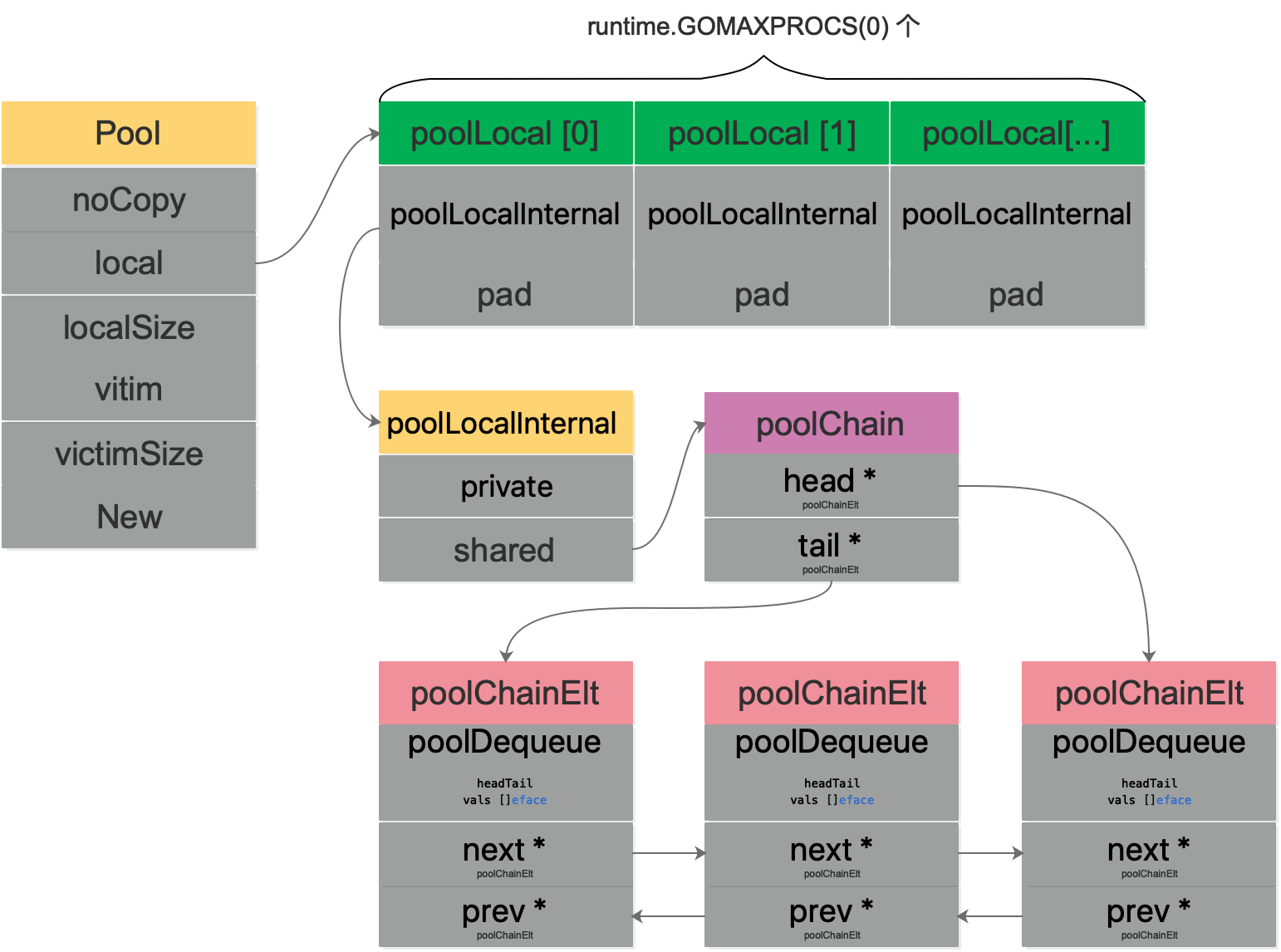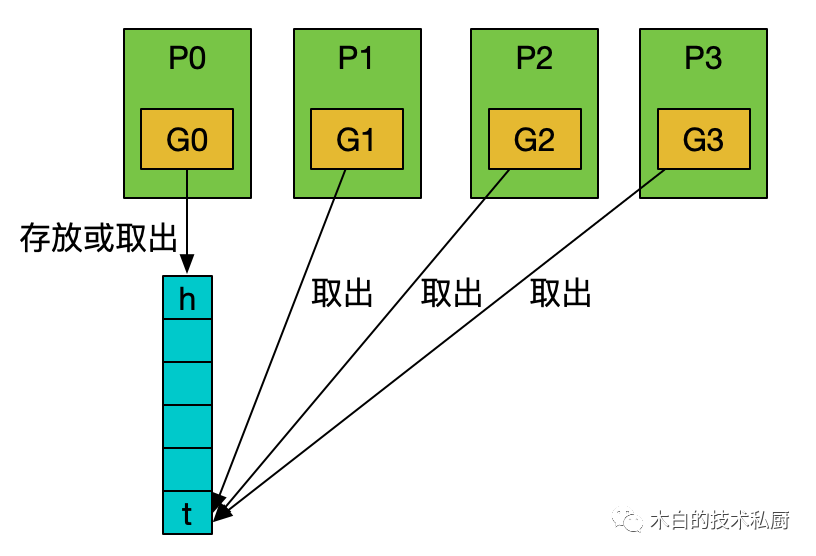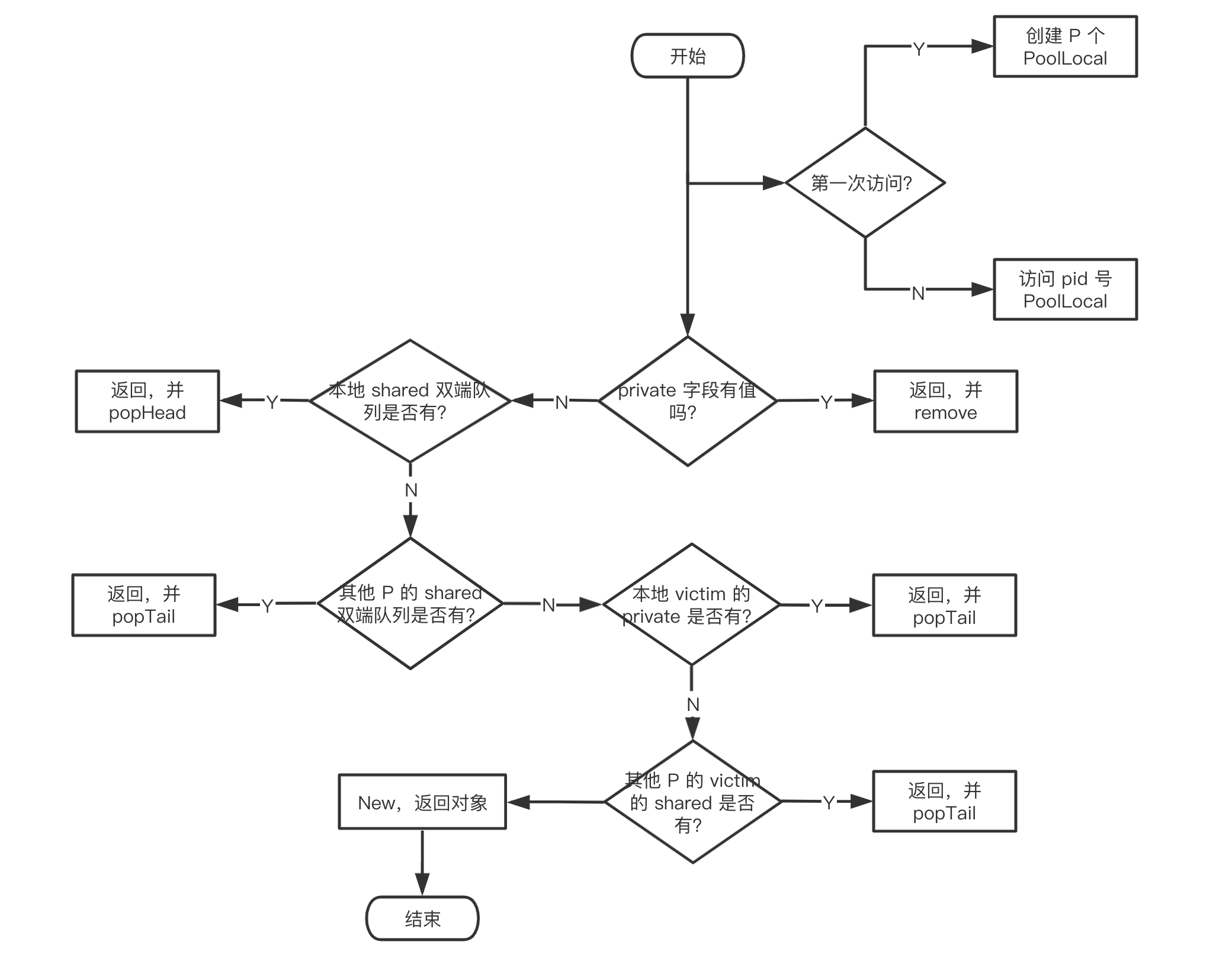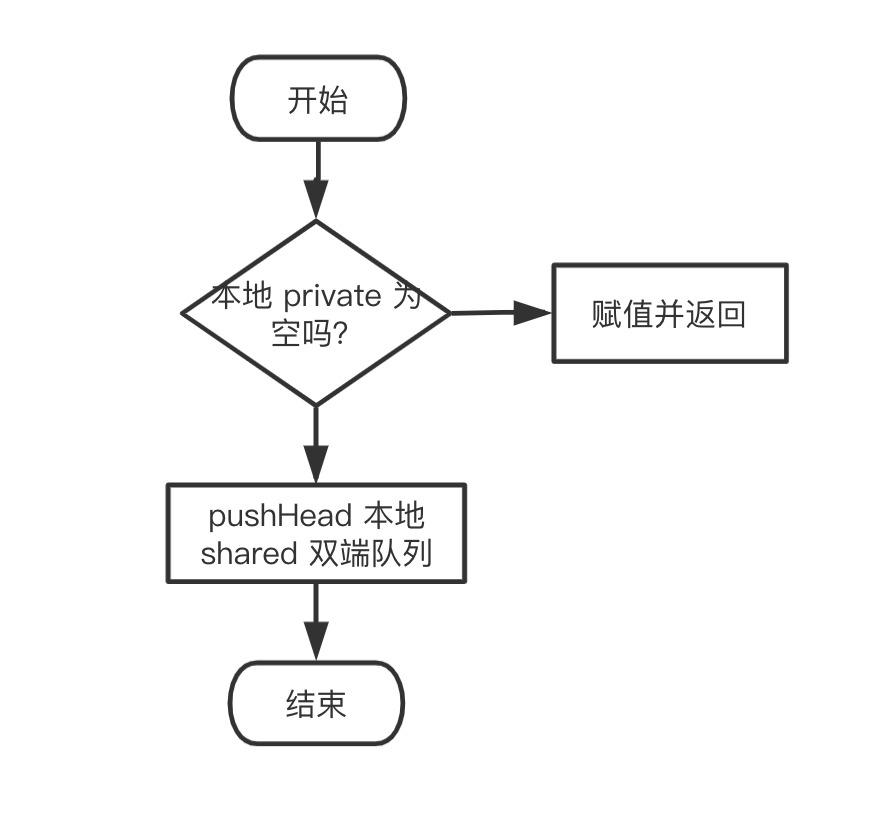sync.Pool是sync包下的一个组件,可以作为临时取还对象的一个 池子.
作用: 对于很多需要重复分配、回收内存的地方,sync.Pool 是一个很好的选择.频繁地分配、回收内存会给 GC 带来一定的负担,严重的时候会引起 CPU 的毛刺,而 sync.Pool 可以将暂时不用的对象缓存起来m待下次需要的时候直接使用,不用再次经过内存分配,复用对象的内存,减轻 GC 的压力,提升系统的性能.
使用场景:
- 当多个 goroutine 都需要创建同⼀个对象的时候,如果 goroutine 数过多,导致对象的创建数⽬剧增,进⽽导致 GC 压⼒增大.形成”并发⼤-占⽤内存⼤-GC 缓慢-处理并发能⼒降低-并发更⼤”这样的恶性循环.
- 关键思想就是对象的复用,避免重复创建.销毁.
Pool原理详解
type Pool struct {
noCopy noCopy
local unsafe.Pointer // local fixed-size per-P pool, actual type is [P]poolLocal
localSize uintptr // size of the local array
victim unsafe.Pointer // local from previous cycle
victimSize uintptr // size of victims array
// New optionally specifies a function to generate
// a value when Get would otherwise return nil.
// It may not be changed concurrently with calls to Get.
New func() any
}- noCopy:
- local: 每个P的本地队列,实际类型为
[P]poolLocal - localSize:
- victicm:
- victicmSize:
- New: 自定义创建对象的回调函数,当pool中没有都可用对象时会调用
1. noCopy
nocopy:
因为Pool不希望被复制,所以结构体里面有一个noCopy字段, 使用 go vet 工具可以检查用户是否复制了 Pool.
用户只需要实现这样不需要消耗内存的,仅用于静态分析的结构, 保证对象在第一次使用后不会发生复制.
// noCopy may be embedded into structs which must not be copied
// after the first use.
// noCopy 可以被嵌入结构体来保证其第一次使用后不会在被复制.
//
// See https://golang.org/issues/8005#issuecomment-190753527
// for details.
type noCopy struct{}
// Lock is a no-op used by -copylocks checker from `go vet`.
// Lock 是一个空操作用来给 `go ve` 的 -copylocks 静态分析
func (*noCopy) Lock() {}
func (*noCopy) Unlock() {}2. local
local字段指向 [P]poolLocal 数组(切片)的指针, localSize 则表示 这个数组的大小. 访问时 P 的 id 对应 [P]poolLocal 下标索引, 这样的设计减少了 多个goroutine 的竞争,提升了性能.
2.1 poolLocal
type poolLocal struct {
poolLocalInternal
// 将 poolLocal 补齐至两个缓存行的倍数,防止 false sharing,
// 每个缓存行具有 64 bytes,即 512 bit$$
// 目前我们的处理器一般拥有 32 * 1024 / 64 = 512 条缓存行
// 伪共享,仅占位用,防止在 cache line 上分配多个 poolLocalInternal
//
// Prevents false sharing on widespread platforms with$$
// 128 mod (cache line size) = 0 .
pad [128 - unsafe.Sizeof(poolLocalInternal{})%128]byte
}2.2 poolLocalInternal
// Local per-P Pool appendix.
type poolLocalInternal struct {
private any // Can be used only by the respective P. 仅能被各自的 P 获取
shared poolChain // Local P can pushHead/popHead; any P can popTail. 本地P可以从头部取, 其他 P 从尾部取
}
2.3 poolChain
// poolChain is a dynamically-sized version of poolDequeue.
//
// This is implemented as a doubly-linked list queue of poolDequeues
// where each dequeue is double the size of the previous one. Once a
// dequeue fills up, this allocates a new one and only ever pushes to
// the latest dequeue. Pops happen from the other end of the list and
// once a dequeue is exhausted, it gets removed from the list.
type poolChain struct {
// head is the poolDequeue to push to. This is only accessed
// by the producer, so doesn't need to be synchronized.
head *poolChainElt
// tail is the poolDequeue to popTail from. This is accessed
// by consumers, so reads and writes must be atomic.
tail *poolChainElt
}
type poolChainElt struct {
poolDequeue
// next and prev link to the adjacent poolChainElts in this
// poolChain.
//
// next is written atomically by the producer and read
// atomically by the consumer. It only transitions from nil to
// non-nil.
//
// prev is written atomically by the consumer and read
// atomically by the producer. It only transitions from
// non-nil to nil.
next, prev *poolChainElt
}
//
// poolDequeue is a lock-free fixed-size single-producer,
// multi-consumer queue. The single producer can both push and pop
// from the head, and consumers can pop from the tail.
//
// It has the added feature that it nils out unused slots to avoid
// unnecessary retention of objects. This is important for sync.Pool,
// but not typically a property considered in the literature.
type poolDequeue struct {
// headTail 包含一个 32 位的 head 和一个 32 位的 tail 指针. 这两个值都和 len(vals)-1 取模过.
// tail 是队列中最老的数据,head 指向下一个将要填充的 slot
// slots 的有效范围是 [tail, head),由 consumers 持有.
//
// headTail packs together a 32-bit head index and a 32-bit
// tail index. Both are indexes into vals modulo len(vals)-1.
//
// tail = index of oldest data in queue
// head = index of next slot to fill
//
// Slots in the range [tail, head) are owned by consumers.
// A consumer continues to own a slot outside this range until
// it nils the slot, at which point ownership passes to the
// producer.
//
// The head index is stored in the most-significant bits so
// that we can atomically add to it and the overflow is
// harmless.
headTail uint64
//
// vals 是一个存储 interface{} 的环形队列,它的 size 必须是 2 的幂
// 如果 slot 为空,则 vals[i].typ 为空;否则,非空.
// 一个 slot 在这时宣告无效: tail 不指向它了,vals[i].typ 为 nil
// 由 consumer 设置成 nil,由 producer 读
//
// vals is a ring buffer of interface{} values stored in this
// dequeue. The size of this must be a power of 2.
//
// vals[i].typ is nil if the slot is empty and non-nil
// otherwise. A slot is still in use until *both* the tail
// index has moved beyond it and typ has been set to nil. This
// is set to nil atomically by the consumer and read
// atomically by the producer.
vals []eface
}
poolDequeue 被设计成单生产者,多消费者固定长度&&无锁的 双端队列.
producer 可以从head插入和删除. consumer可以从尾部pop 数据.
headTail 指向队头和队尾, 通过位运算, 将 head & tail 存入 headTail中.


我们看到 Pool 并没有直接使用
poolDequeue,原因是它的大小是固定的,而 Pool 的大小是没有限制的.
因此,在poolDequeue之上包装了一下,变成了一个poolChainElt的双向链表,可以动态增长.
3. victim
一轮 GC 完成后,victim 和 victimSize 会分别接管 local 和 localSize,victim 的机制用于减少GC后冷启动导致的性能抖动. 让分配对象更加平滑.
victim Cache 本来是计算机架构里面的一个概念,是让CPU硬件处理缓存的一种技术,
sync.Pool引入的意图在于 降低GC压力的同时增加缓存命中率.
4. New
当Pool中没有对象可供提供时,会调用 New 生成一个新对象.
2. 源码详解
2.1. Get
// Get selects an arbitrary item from the Pool, removes it from the
// Pool, and returns it to the caller.
// Get may choose to ignore the pool and treat it as empty.
// Callers should not assume any relation between values passed to Put and
// the values returned by Get.
//
// If Get would otherwise return nil and p.New is non-nil, Get returns
// the result of calling p.New.
func (p *Pool) Get() any {
if race.Enabled {
race.Disable()
}
// 将当前的 goroutine 和 P绑定,禁止被强占,返回当前P对应的 localPool & pid
l, pid := p.pin()
x := l.private
l.private = nil
if x == nil {
// Try to pop the head of the local shard. We prefer
// the head over the tail for temporal locality of
// reuse.
x, _ = l.shared.popHead()
if x == nil {
// 尝试从 qita P 的 shared 双端队列尾部头一个对象出来.
x = p.getSlow(pid)
}
}
// pool 操作完成之后, 接触非抢占
runtime_procUnpin()
if race.Enabled {
race.Enable()
if x != nil {
race.Acquire(poolRaceAddr(x))
}
}
// 如果最后还是没有获取到缓存对象,那就直接调用预先设置好的回调函数 `New` 创建一个对象.
if x == nil && p.New != nil {
x = p.New()
}
return x
}
2.1.1 pin
// pin pins the current goroutine to P, disables preemption and
// returns poolLocal pool for the P and the P's id.
// Caller must call runtime_procUnpin() when done with the pool.
func (p *Pool) pin() (*poolLocal, int) {
pid := runtime_procPin()
// In pinSlow we store to local and then to localSize, here we load in opposite order.
// Since we've disabled preemption, GC cannot happen in between.
// Thus here we must observe local at least as large localSize.
// We can observe a newer/larger local, it is fine (we must observe its zero-initialized-ness).
s := runtime_LoadAcquintptr(&p.localSize) // load-acquire
l := p.local // load-consume
// 因为可能存在动态的 P(运行时调整 P 的个数)
if uintptr(pid) < s {
return indexLocal(l, pid), pid
}
return p.pinSlow()
}调用方必须在完成取值后,调用 runtime.proc_Unpin() 来取消抢占.
pin 的作用就是将当前 groutine 和 P 绑定在一起,禁止抢占. 并且返回对应的 poolLocal 以及 P 的 id。
如果 G 被抢占,则 G 的状态从 running 变成 runnable,会被放回 P 的 localq 或 globaq,等待下一次调度.
下次再执行时,就不一定是和现在的 P 相结合了. 因为之后会用到 pid,如果被抢占了,有可能接下来使用的 pid 与所绑定的 P 并非同一个.
func (p *Pool) pinSlow() (*poolLocal, int) {
// Retry under the mutex.
// Can not lock the mutex while pinned.
runtime_procUnpin()
allPoolsMu.Lock()
defer allPoolsMu.Unlock()
pid := runtime_procPin()
// poolCleanup won't be called while we are pinned.
s := p.localSize
l := p.local
if uintptr(pid) < s {
return indexLocal(l, pid), pid
}
if p.local == nil {
allPools = append(allPools, p)
}
// If GOMAXPROCS changes between GCs, we re-allocate the array and lose the old one.
size := runtime.GOMAXPROCS(0)
local := make([]poolLocal, size)
atomic.StorePointer(&p.local, unsafe.Pointer(&local[0])) // store-release
runtime_StoreReluintptr(&p.localSize, uintptr(size)) // store-release
return &local[pid], pid
}因为有一把大锁 allPoolsMu, 所以函数名带有 slow. 锁粒度越大,竞争越多,就越慢. 不过想要上锁的话,先要解除绑定. 原因是锁越大,被阻塞的概率越大,如果还占着 P, 那就浪费资源.
2.1.2 popHead
func (c *poolChain) pushHead(val any) {
d := c.head
if d == nil {
// Initialize the chain.
const initSize = 8 // Must be a power of 2
d = new(poolChainElt)
d.vals = make([]eface, initSize)
c.head = d
storePoolChainElt(&c.tail, d)
}
if d.pushHead(val) {
return
}
// The current dequeue is full. Allocate a new one of twice
// the size.
newSize := len(d.vals) * 2
if newSize >= dequeueLimit {
// Can't make it any bigger.
newSize = dequeueLimit
}
d2 := &poolChainElt{prev: d}
d2.vals = make([]eface, newSize)
c.head = d2
storePoolChainElt(&d.next, d2)
d2.pushHead(val)
}
func (c *poolChain) popHead() (any, bool) {
d := c.head
for d != nil {
// 调用 dequeue 的 popHead
if val, ok := d.popHead(); ok {
return val, ok
}
// There may still be unconsumed elements in the
// previous dequeue, so try backing up.
d = loadPoolChainElt(&d.prev)
}
return nil, false
}popHead 只会被 producer调用,首先拿到头结点: ,如果头结点不为空,尝试调用 头结点(poolDequeue)的 popHead().
// 自旋锁的模式,避免加锁.
//
// popHead removes and returns the element at the head of the queue.
// It returns false if the queue is empty. It must only be called by a
// single producer.
func (d *poolDequeue) popHead() (any, bool) {
var slot *eface
for {
ptrs := atomic.LoadUint64(&d.headTail)
head, tail := d.unpack(ptrs)
if tail == head {
// Queue is empty.
return nil, false
}
// head 是队头的前一个位置,所以要后移一位.
// 在读出 slot 的 value 之前就将 head值 -1,取消对这个 slot 的控制.
// Confirm tail and decrement head. We do this before
// reading the value to take back ownership of this
// slot.
head--
ptrs2 := d.pack(head, tail)
if atomic.CompareAndSwapUint64(&d.headTail, ptrs, ptrs2) {
// We successfully took back slot.
slot = &d.vals[head&uint32(len(d.vals)-1)]
break
}
}
val := *(*any)(unsafe.Pointer(slot))
if val == dequeueNil(nil) {
val = nil
}
// Zero the slot. Unlike popTail, this isn't racing with
// pushHead, so we don't need to be careful here.
*slot = eface{}
return val, true
}通过 自旋锁的模式(for 循环 + CAS) 避免加锁.
2.1.3 getSlow
如果在 shared里面没有获得缓存对象,则继续调用 Pool.getSlow, 尝试从其他 P 的 poolLocal 中偷取.
func (p *Pool) getSlow(pid int) any {
// See the comment in pin regarding ordering of the loads.
size := runtime_LoadAcquintptr(&p.localSize) // load-acquire
locals := p.local // load-consume
// 尝试从其他P中偷取 对象.
// Try to steal one element from other procs.
for i := 0; i < int(size); i++ {
l := indexLocal(locals, (pid+i+1)%int(size))
if x, _ := l.shared.popTail(); x != nil {
return x
}
}
// 尝试从victim cache中取对象。这发生在尝试从其他 P 的 poolLocal 偷去失败后,
// 因为这样可以使 victim 中的对象更容易被回收.
//
// Try the victim cache. We do this after attempting to steal
// from all primary caches because we want objects in the
// victim cache to age out if at all possible.
size = atomic.LoadUintptr(&p.victimSize)
if uintptr(pid) >= size {
return nil
}
locals = p.victim
l := indexLocal(locals, pid)
if x := l.private; x != nil {
l.private = nil
return x
}
for i := 0; i < int(size); i++ {
l := indexLocal(locals, (pid+i)%int(size))
if x, _ := l.shared.popTail(); x != nil {
return x
}
}
// 清空 victimCache,下次就不用从这里面找了.
// Mark the victim cache as empty for future gets don't bother
// with it.
atomic.StoreUintptr(&p.victimSize, 0)
return nil
}- 从索引为 pid + 1 的 poolLocal 开始, 尝试调用shared.popTail 获取缓存对象. 如果没有拿到,从victim中查找. 和 从 poolLocal 的逻辑类似.
- 最后 如果还没有找到,就把 victimSize 值 0. 防止后来的人再从 victim中找.
- 在 Get 函数的最后,经过这一番操作还是没找到缓存的对象,就调用 New 函数创建一个新的对象.
2.1.4 popTail
func (c *poolChain) popTail() (any, bool) {
d := loadPoolChainElt(&c.tail)
if d == nil {
return nil, false
}
for {
// It's important that we load the next pointer
// *before* popping the tail. In general, d may be
// transiently empty, but if next is non-nil before
// the pop and the pop fails, then d is permanently
// empty, which is the only condition under which it's
// safe to drop d from the chain.
d2 := loadPoolChainElt(&d.next)
if val, ok := d.popTail(); ok {
return val, ok
}
if d2 == nil {
// This is the only dequeue. It's empty right
// now, but could be pushed to in the future.
return nil, false
}
// The tail of the chain has been drained, so move on
// to the next dequeue. Try to drop it from the chain
// so the next pop doesn't have to look at the empty
// dequeue again.
if atomic.CompareAndSwapPointer((*unsafe.Pointer)(unsafe.Pointer(&c.tail)), unsafe.Pointer(d), unsafe.Pointer(d2)) {
// We won the race. Clear the prev pointer so
// the garbage collector can collect the empty
// dequeue and so popHead doesn't back up
// further than necessary.
// 甩掉尾结点.
storePoolChainElt(&d2.prev, nil)
}
d = d2
}
}// popTail removes and returns the element at the tail of the queue.
// It returns false if the queue is empty. It may be called by any
// number of consumers.
func (d *poolDequeue) popTail() (any, bool) {
var slot *eface
for {
ptrs := atomic.LoadUint64(&d.headTail)
head, tail := d.unpack(ptrs)
if tail == head {
// Queue is empty.
return nil, false
}
// Confirm head and tail (for our speculative check
// above) and increment tail. If this succeeds, then
// we own the slot at tail.
ptrs2 := d.pack(head, tail+1)
if atomic.CompareAndSwapUint64(&d.headTail, ptrs, ptrs2) {
// Success.
slot = &d.vals[tail&uint32(len(d.vals)-1)]
break
}
}
// We now own slot.
val := *(*any)(unsafe.Pointer(slot))
if val == dequeueNil(nil) {
val = nil
}
// Tell pushHead that we're done with this slot. Zeroing the
// slot is also important so we don't leave behind references
// that could keep this object live longer than necessary.
//
// We write to val first and then publish that we're done with
// this slot by atomically writing to typ.
slot.val = nil
atomic.StorePointer(&slot.typ, nil)
// At this point pushHead owns the slot.
return val, true
}2.2. Put
// Put adds x to the pool.
func (p *Pool) Put(x any) {
if x == nil {
return
}
if race.Enabled {
if fastrandn(4) == 0 {
// Randomly drop x on floor.
return
}
race.ReleaseMerge(poolRaceAddr(x))
race.Disable()
}
l, _ := p.pin()
if l.private == nil {
l.private = x
x = nil
}
if x != nil {
l.shared.pushHead(x)
}
runtime_procUnpin()
if race.Enabled {
race.Enable()
}
}
- 先绑定 g 和 P. 然后尝试将 x 赋值给 private字段.
- 如果失败. 就调用 pushHead() 尝试将其放入 shared字段 维护的双端队列中.

2.2.1 pushHead
func (c *poolChain) pushHead(val any) {
d := c.head
if d == nil {
// Initialize the chain.
const initSize = 8 // Must be a power of 2
d = new(poolChainElt)
d.vals = make([]eface, initSize)
c.head = d
storePoolChainElt(&c.tail, d)
}
if d.pushHead(val) {
return
}
// 当前 poolDequeue 满了. 分配一个 当前 poolDequeue 2倍的一个 poolDequeue
// The current dequeue is full. Allocate a new one of twice
// the size.
newSize := len(d.vals) * 2
if newSize >= dequeueLimit {
// Can't make it any bigger.
newSize = dequeueLimit
}
// 收尾相连. 构成链表
d2 := &poolChainElt{prev: d}
d2.vals = make([]eface, newSize)
c.head = d2
storePoolChainElt(&d.next, d2)
d2.pushHead(val)
}// // 将 val 添加到双端队列头部。如果队列已满,则返回 false。此函数只能被一个生产者调用
//
// pushHead adds val at the head of the queue. It returns false if the
// queue is full. It must only be called by a single producer.
func (d *poolDequeue) pushHead(val any) bool {
ptrs := atomic.LoadUint64(&d.headTail)
head, tail := d.unpack(ptrs)
//队列满了
if (tail+uint32(len(d.vals)))&(1<<dequeueBits-1) == head {
// Queue is full.
return false
}
slot := &d.vals[head&uint32(len(d.vals)-1)]
// Check if the head slot has been released by popTail.
typ := atomic.LoadPointer(&slot.typ)
if typ != nil {
// Another goroutine is still cleaning up the tail, so
// the queue is actually still full.
return false
}
// The head slot is free, so we own it.
if val == nil {
val = dequeueNil(nil)
}
*(*any)(unsafe.Pointer(slot)) = val
// Increment head. This passes ownership of slot to popTail
// and acts as a store barrier for writing the slot.
atomic.AddUint64(&d.headTail, 1<<dequeueBits)
return true
}